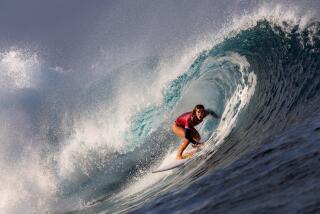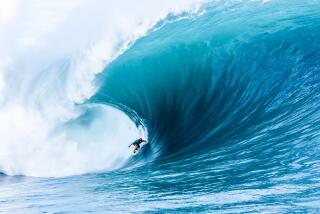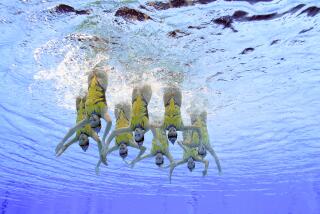Come on in, surfer girls -- the water’s fine
- Share via
Sure, girl surfers have plenty of worries before taking to the waves, stuff that might never cross a man’s mind. And losing a limb to a shark isn’t necessarily one of them.
But predatory males of the human variety can pose plenty of hazards. Then there’s the whole bikini dilemma: aesthetics versus staying power. Your swimsuit needs to go where you go, come hell or high waves. How cute will that thong look when it’s floating out to sea?
Your breasts get smushed against the board, the saltwater wrecks your hair, and the only place to change clothes is in the parking lot.
Plus, you, a novice, must learn your sport in public, in revealing clothes, all alone, so that all those hot surfer boys can watch you make a crashing fool of yourself at every botched turn. Why shouldn’t self-esteem issues haunt you at the beach?
At last, there’s “Surf’s Up: The Girl’s Guide to Surfing,” a book to get you off your tummy and onto your feet as the waves crest behind you -- and preferably not over you.
You’ll be in good company, since 37% of American surfers are now women, according to Louise Southerden, an Australian surfer and journalist who sums it all up for the wannabe wahine.
With boards now shaped for female frames and wetsuits fitted to accommodate curves, plus all-girl competitions, magazines and surf shops, all that stands in a surfer girl’s way are the crowds of people racing for the beach.
This is a far cry from the 1970s, when the chant heard from San Diego to Santa Cruz was “no chicks on sticks.” Why any man would object to having scantily clad women join him in the water remains something of a mystery, but fortunately such machismo seems to have vanished.
As for learning the ups and downs -- and for beginners, it’s mostly downs -- it’s all here but the sand: choosing equipment and finding a surf school, researching surf conditions and, of course, how to actually make the board move.
Much of the advice could as easily apply to men, and there’s a minimum of male bashing except to bemoan their occasional tendency to hog the waves.
Then again, a dose of estrogen seems to help the tribe, as surfers like to call themselves, by bringing out the last remnants of chivalry and calming down the more competitive types.
But Southerden recognizes her surfing sisters’ big downfall: given a co-ed environment, a beginner may not focus as much on staying afloat as on how her bottom looks in neoprene. She recommends all-girl lessons and outings, at least at first.
Southerden is as long on pep talks and inspiration as she is on how-to’s: Get out there because it’s beautiful, because the ocean doesn’t care about testosterone levels, because it bleaches your hair and buffs your bod; but mostly, get out there because it’s the most thrilling way to exhaust yourself while standing up.
For all her enthusiasm, however, Southerden’s prose is occasionally dry, and some sections read more like a meteorology primer. A sprinkling of women’s voices throughout the book lifts it out of the esoteric and lands the reader back on firm ground with witty asides and prudent tips.
Bethany Hamilton, a teenager who lost an arm to a shark two years ago, advises surfing in groups and then getting the heck outta there if a problem arises: “If you see a shark, catch a wave! Or at least lie still on your board and keep your arms and legs together!”
So what are you waiting for?
Surf’s up, dudette.
Anne Boles Levy is a reviewer whose work has appeared in The Times and who also writes a children’s book blog at www.bookbuds.net


